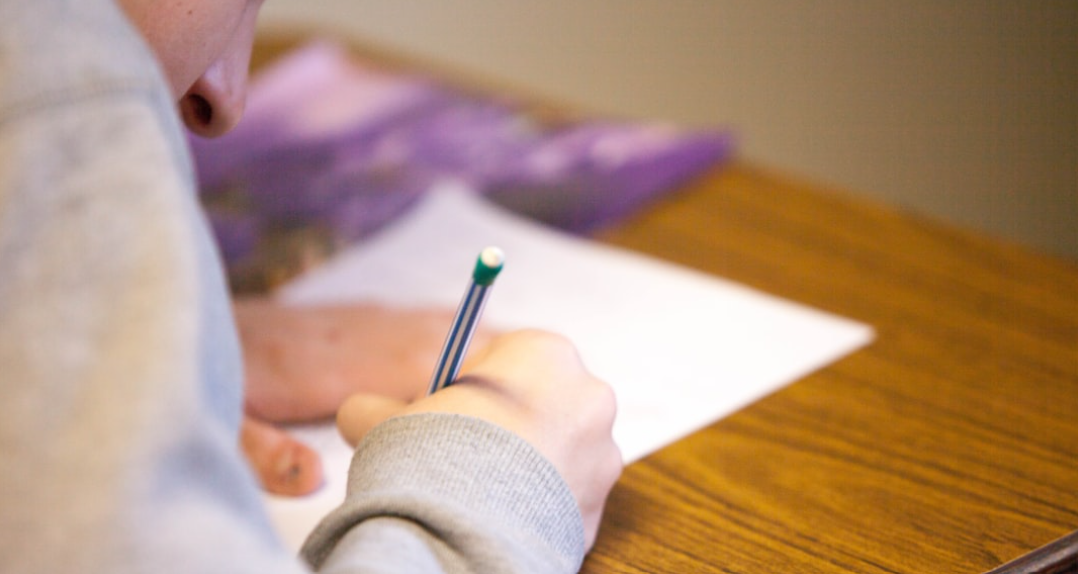
Editor’s Note: Education 540 is an occasional series that aims to broaden our public discourse about education. These essays are by those on the frontlines of education who 1) respect research, 2) appreciate the complexities of policy, and 3) understand the depth of emotions and deeply held beliefs of those affected by public education. The goal of this series is simple — restore nuance and a touch of bold thinking into the Education Wars. If you’d like to write, submit articles or ideas to the editor.
Not being a morning person, a 5:30 a.m. alarm on a Tuesday morning is usually met with a series of grunts, mumbles, and the occasional swear word. This past Tuesday, however, the alarm didn’t get an opportunity to jolt me from sleep. I was awake a half hour before it was scheduled to go off.
It was the first full day of school at James Monroe High School, and the first day with the school’s new no-cell-phone policy. As a part-time teacher this year whose classes didn’t begin until Wednesday, I nonetheless volunteered to help with Tuesday’s distribution.
Having penned one column about the problems with cell phones in schools, and having edited the many pieces Adele Uphaus has written chronicling the cascade of school districts in our region adopting bans, the opportunity to observe first-hand a new policy become reality was too enticing to sleep on.
Arriving at James Monroe High School at 6:45, I walked to the office to join the 20 or so teachers who volunteered to help distribute the new Yondr pouches that students would place their phones in.
Walking between the columns that line the school’s semicircular entrance, one sees what awaited newly arriving students. Tables were placed between the columns and marked with signs designating each by class year and last name — Sophomores A-F, for example.
In the office, the administrative team explained the finer points of distributions, and encouraged us to make this first experience on the first day as pleasant as possible. The goal here, after all, is not to punish, but to help everyone become a better version of themselves by encouraging conversation, friendships, and better interactions with teachers so the school becomes a better place to learn.
As students arrived, the faculty reflected that request. They greeted students with smiles, “Welcome backs,” the occasional joke, and the kids’ new Yondr pouches.

There were lots of student questions: “Do I have to turn the pouch in at the end of the day?” (No, it’s yours for the year.) “What if I just left my phone at home?” (No problem, you still get a pouch for the year so when you do bring your phone you are able to store it.) “What if my phone won’t fit?” (It’ll fit.) “Ear buds, too?” (Yep.) “How do I get it back open?” (At the end of the day, just tap the lock against the unlocking magnet.)
What there wasn’t was defiance.
Throughout the summer, some students had taken to social media to protest the new policy. Some teachers quietly anticipated there’d be a power struggle on the first day.
In fact, students dutifully put their phones in the pouches, locked them up, and went on their way to class.
According to Fredericksburg School District’s Assistant Superintendent Matt Eberhardt, just one phone had to be confiscated at JM on Tuesday, and three each on Wednesday and Thursday. At Walker Grant Middle School, not a single phone had to be confiscated over the first three days of the new school year.
“Our students are doing a great job following the new rule and are being cooperative,” he told the Advance via text message on Thursday. “All staff seem to be onboard” as well.
A Policy That – Early on – Is Working
At a faculty meeting on Wednesday, as JM’s Principal Marcus Petty was moving toward the stage in the lecture hall, the teachers greeted him with a loud, boisterous ovation. It was a demonstration of appreciation for attacking the cell-phone issue, which post-COVID has proven increasingly difficult to control in the classroom, leading to an array of difficulties.
“I’ve never seen anything like it,” one long-time educator told the Advance.
According to another, it was spontaneous, a celebration that Petty and the district had heard their concerns and were moving the school in the right direction. “We can teach again,” this person said.
A growing body of research has suggested that the issue of cell phones in students’ hands is more than a distraction; rather, it’s an addiction that is crippling young people’s ability to communicate, learn, and mature. Not all scholars agree, of course, with some building a case that learning to responsibly engage with smart phones in schools is critical for young people’s growth.
Further, there are parents who disagree with the policy.
For teachers in the classrooms and on duties, however, the impact of the ban has been immediate — and overwhelmingly for the better.
“I’ve had several kids,” one teacher said to the Advance, “who’ve said they are less stressed with the phone out of their hands.”
Other teachers have celebrated not losing class-time to playing phone cop.
In my own classes, I’ve noticed a profound difference from last year. Students are more dialed-in to what’s happening in the room, even if they’re not always thrilled with what’s being discussed. (Kids being bored with teachers and lessons, however, is hardly a new issue.)
But nowhere this past week has the difference been more profound than in the hallways and in the lunch area.
Stepping downstairs on Wednesday from my usual haunt — the second-floor hall where the history department is located — into the commons area where lunch is served, one could immediately hear the difference from a year before.
It was noisy — not in the sense of obnoxious and wild, but in the sense of youthful exuberance and excitement.
Students who last year spent their lunch time with noses buried in their smart phone screens were now talking with friends. Other students were playing games like paper football, but with a pack of Pop Tarts instead of a folded paper football.
It’s the immediate improvements in the classrooms, in the commons area, and in the hallways that led to teachers applauding Petty. But that wasn’t the sole reason.
There’s a renewed sense that the district is rowing in the same direction on this issue, and that with support from top to bottom this time the initiative has a chance. As one teacher told the Advance, “It’s been a significant change, and for that reason I’m ‘cautiously’ optimistic.”
Indeed, there are 35 weeks remaining in this school year. So, the extent to which this policy succeeds hinges on continuing to build upon the momentum established this past week.
With students cooperating, teachers feeling better about being able to focus on teaching, and an administration feeling emboldened to see this policy through, there’s reason to believe the story this coming May will be even better than the story following the first week.
Improvement Starts with the Intangibles
The big question, of course, is will the ban simply improve the environment for everyone involved in working and learning at JM? Or will it lead to academic improvements for the students, too?
For better or worse — and I would argue mostly worse — we talk about academic achievement in terms of test scores. Invariably, as Fredericksburg City Schools’ experiment with cell-phone bans progresses, its success will be judged by improved performance on SOL scores.
The city school system has struggled with these scores for several years, and as recently reported, the unadjusted SOL scores from this spring are a mixed bag of results that don’t suggest the district will see dramatic improvement when the adjusted scores are released later this fall.
Fortunately, there’s reason to believe that this move by the city to ban cell phones will have a positive effect on test scores.
Matt Hurt is a leading data analyst who runs the Comprehensive Instructional Program. Districts that have joined the consortium have, generally, seen academic improvements on SOL scores well above non-CIP districts.
Using SOL testing to sharpen teaching is a key element of this program, but Hurt is increasingly convinced that it is the intangible factors that can’t be so easily measured with data that have the greatest impact on children.
(Full disclosure, Hurt and I are in the early phases of cooperating on a book.)
“When you walk into a school building,” he told the Advance on Saturday, “it doesn’t take long to figure out if a school has a healthy environment. If you’re greeted warmly, when it’s clear teachers and students want to be there, these are the schools that tend to be successful.”
Measuring intangibles is difficult, but it’s not impossible. The School Climate Survey attempts to capture in data things like: School Engagement, Caring Relationships, High Expectations, and Fostering Safety. (For a look at the history, strengths, and weaknesses of this survey, see “The Fifth Indicator: Does School Climate Provide New Information on School Quality” produced by the University of Virginia’s Curry School and Batten School.)
In a piece for Bacon’s Rebellion, Hurt had the following to say about the 2023 Climate Survey results.
This spring some of my colleagues and I were able to obtain and investigate the annual School Climate and Working Conditions Survey results from 2023. We specifically focused on the teacher results and were able to confirm a major tenet in the educational world: climate matters!
How much?
One singular question — overall, my school is a good place to work and learn — had the greatest overall correlation with both SOL outcomes and teacher vacancy rates. In other words, teachers were less likely to leave divisions in which they wanted to work, and those divisions produced better student outcomes.
According to Hurt, cell phone use falls into this intangible category.
When kids aren’t on their phones, he told the Advance, they’re engaged with one another. And when that happens, they are working on getting to know one another. Getting more involved in their school and their work.
For the moment, the administrators, students, and teachers at JM don’t need a sophisticated data study to tell them that things are getting better. They are seeing it and living it every day.
And they’re applauding the improvement.
Follow us on Facebook | Instagram | Youtube

Local Obituaries
To view local obituaries or to send a note to family and loved ones, please visit our website at the link that follows.

Support Award-winning, Locally Focused Journalism

The FXBG Advance cuts through the talking points to deliver both incisive and informative news about the issues, people, and organizations that daily affect your life. And we do it in a multi-partisan format that has no equal in this region. Over the past month, our reporting was:
$8 a month supports great journalism
- First to report on a Spotsylvania School teacher arrested for bringing drugs onto campus.
- First to report on new facility fees leveled by MWHC on patient bills.
- First to detail controversial traffic numbers submitted by Stafford staff on the Buc-ee’s project
- Provided extensive coverage of the cellphone bans that are sweeping local school districts.
- And so much more, like Clay Jones, Drew Gallagher, Hank Silverberg, and more.
For just $8 a month, you can help support top-flight journalism that puts people over policies.
Your contributions 100% support our journalists.
Help us as we continue to grow!





